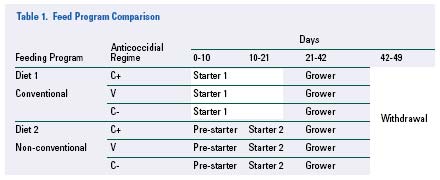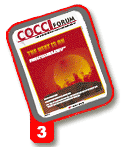Technically Speaking
Using Coccidiosis Vaccination to Optimize your Nutrition Program
 Dr. César Carnicer García
Schering-Plough Animal
Health, Spain
|
Across the globe, vaccinating
broilers for coccidiosis has
become a more safe, sensible
and cost-effective means of controlling
this costly disease in poultry "and it's
easy to understand why.
Not only does vaccination eliminate
the need for residue-causing and resistance-
prone in-feed coccidiostats, it provides
life-long protection without the
hassle or worry of withdrawal times.
Vaccination has also proved to be an
excellent way to minimize or even
eliminate drugs from poultry diseasemanagement
programs "a benefit that
brings added value to meat produced
by vaccinated birds.
Perhaps the biggest benefit to coccidiosis
vaccination still hasn't been
realized, however. By eliminating the
need for in-feed coccidiostats "products
that must be fed for specific durations
to be effective "vaccination also
provides more flexibility in the feeding
program and, as a result, enhances performance
and profitability for poultry
producers.
Conflicting Goals
The goal of every poultry feed program
is to obtain optimal bird performance,
meat quality and processability for the
cheapest cost per pound (or kilogram)
of produced meat. The primary objective
of an anticoccidial program is to
prevent both acute and subclinical coccidiosis
while preserving the gut's
integrity, reducing secondary disease
and obtaining good growth and performance.
Unfortunately, while it is convenient
to administer coccidiostats through the
feed, it is not always easy to meet both
goals at the same time. This is because
the rigid protocol for using the in-feed
anticoccidial might prevent producers
from making changes in their ration to
optimize nutrition.
An ideal coccidiosis-management
program is therefore one that is free of
side effects, allows optimum feed formulation
for the type and weight of the
birds, permits acceptable feed-mill
management, and ensures the production
of residue-free chicken meat.
How nutrition programs are formulated
will vary from country to country
and farm to farm, but there are a few
standard practices that most operations
tend to follow in their management of
coccidiosis. For example:
"� Starter: 0 to 21 days with a chemical
anticoccidial
"� Grower: 21 to 5 or 7 days before
slaughter with an ionophore
"� Finisher/withdrawal: Until the end of
cycle with no anticoccidial.
For most anticoccidial drugs, the
dosage range is a compromise between
effectiveness and safety, especially with
ionophores. To avoid toxicity, the drugs
sometimes have to be recommended at
sub-optimal dose. In addition, anticoccidial
drugs are not equally effective
against all Eimeria species, and coccidia
can develop resistance to all anticoccidials.
For these reasons, nutritionists and
veterinarians have to devise and implement
complex shuttle and rotation programs
to try and achieve optimal efficacy
with minimal side effects. The
design, implementation and monitoring
of successful shuttle and rotation programs,
however, has become quite
complicated and fraught with obstacles
and risks.

|
For instance, flocks cannot be treated
with nicarbazin during early autumn
or spring because sudden heat waves
can result in high mortality, even in
young birds. While valuable to the
industry, ionophores can also present
some problems. In northern Ireland, for
example, detectable residual levels of
the coccidiostat lasalocid were found in
table eggs. The contaminated eggs
were traced back to a feed mill that also
produced broiler feed.
A problem that is relatively common
and devastating in its consequences is
the accidental feeding of rations containing
coccidiostats to non-target animals.
For example, turkeys fed salinomycin-
containing feed will experience
increased mortality. Broiler breeders
fed nicarbazin can experience a drop
in egg production and fertility.
Last but not least, producers need to
consider the extra time and money
spent by the feed mill for flushing systems
of coccidiostat residues, planning
and mixing batches of medicated feed,
and avoiding cross contamination of
drug-free withdrawal rations.
Nutritional Trial
To obtain a better understanding of
how in-feed coccidiostats can undermine
a nutritional program, we performed
a floor pen trial comparing
three anticoccidial programs (drugs,
vaccination with Paracox-5 and a negative
control), and two different feeding
programs. See Ttable 1 to better understand
the design.
While the trial was conducted in
Spain, the results are applicable to virtually
all major poultry markets.
Diet 1, or the "conventional diet," is
a standard in the Spanish market and is
illustrated in Table 1. Withdrawal feed
was fed for 7 days and the age of
slaughter was 49 days, which is also
common in the Spanish market for
heavy birds.
Diet 2 differs from the conventional
diet in the starter phase; the pre-starter
(0-10) is designed to have better
digestibility and higher essential amino
acid levels with "less aggressive" ingredients.
The feed from 10 to 21 days had
lower energy and protein levels than
the standard starter, so we expected
bird growth to be somewhat slower.
Results

|
Live weight results are presented in
Table 2, page 12.
There were no differences in body
weights at the end of the fattening period
(49 days) among medicated and
vaccinated birds. Diet 2 gave significantly
higher weight than Diet 1.
It is remarkable that control birds had similar weight under any of the
anticoccidial treatments, which reinforces
the idea that no coccidiosis challenge
occurred at the experimental
farm, as expected. Despite that, the
baseline performance of vaccinated
birds did not differ from birds treated
with anticoccidials. It was, in fact,
numerically better if not significantly
better.
Period 0-10 days
There appears to be an interaction
between anticoccidial treatment and
diet. With Diet 2, control birds are in
line with vaccinated birds (no coccidial
challenge).
Vaccinated birds performed much
better than birds receiving an anticoccidial
under Diet 2 (enriched starter)
but do worse with Diet 1 (standard).
This is consistent with the speculation
that a specially tailored diet can be a
big advantage when birds are vaccinated
for coccidiosis.
In practice, assuming that untreated
birds are not feasible in field conditions,
the larger growth rate is obtained
with vaccinated birds and Diet 2, where
there is no growth depressor effect
from nicarbazin and there is a good gut
function due to the diet.
Period 0-21 days
The trend is maintained despite the
fact that Diet 2 was lower in energy
(6%) and protein (3%) than the conventional
diet. This reinforces the idea
that a starter is not really needed
through 21 days.
Other results
There were no significant differences
seen in the feed conversion ratio,
final body weight, daily weight gain or
mortality at 49 days among anticoccidial
treatments.
Based on the literature and the
experience of several nutritional consultants,
it is fair to say that coccidiosis
vaccination can do more than just protect
birds from coccidiosis. The aim is
to fit the typical curve of nutritional
requirements under nutritional and
economic criteria, without worrying
about controlling coccidiosis via infeed
treatment.
Conclusions
Coccidiosis vaccination is the newest
tool available for coccidiosis control.
Since it provides solid, life-lasting
protection, it helps eliminate resistance
and the need for complicated in-feed
anticoccidial programs. It also eliminates
the risks associated with anticoccidial
drugs.
Coccidiosis vaccination allows feed
mills to optimize their diets and provides
for more flexible feeding programs.
Moreover, birds can be removed
at any time from the house, whether an
antibiotic growth promotant has been
used or not, since there is no worry
about chemical residues. Birds can be
sent at any time to the slaughterhouse
after fasting just a few hours, which fosters
more flexible planning and farm
management.
Last but not least, coccidiosis vaccination
represents a major new step
toward more natural meat, which is
increasingly in public demand
Source: CocciForum Issue No.3, Schering-Plough Animal Health.







